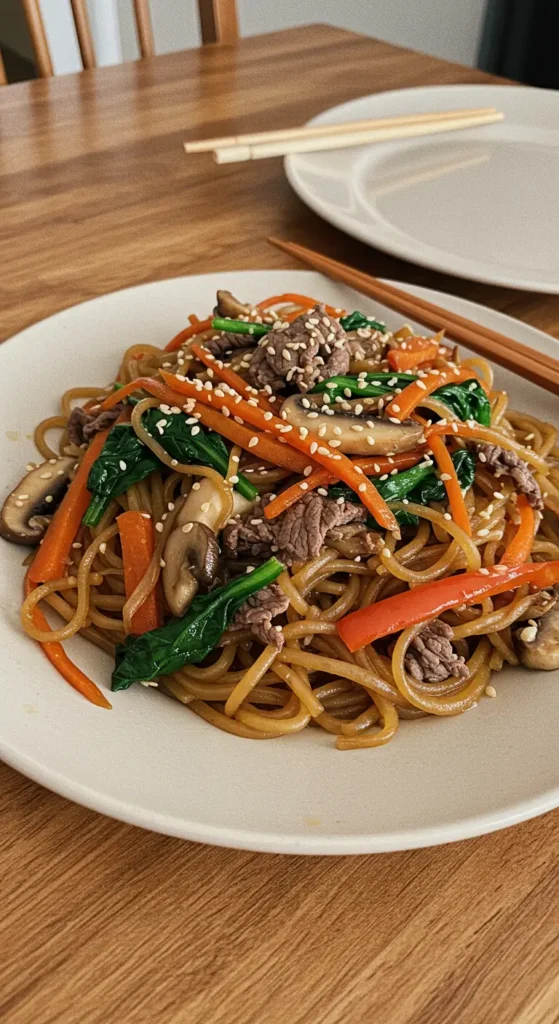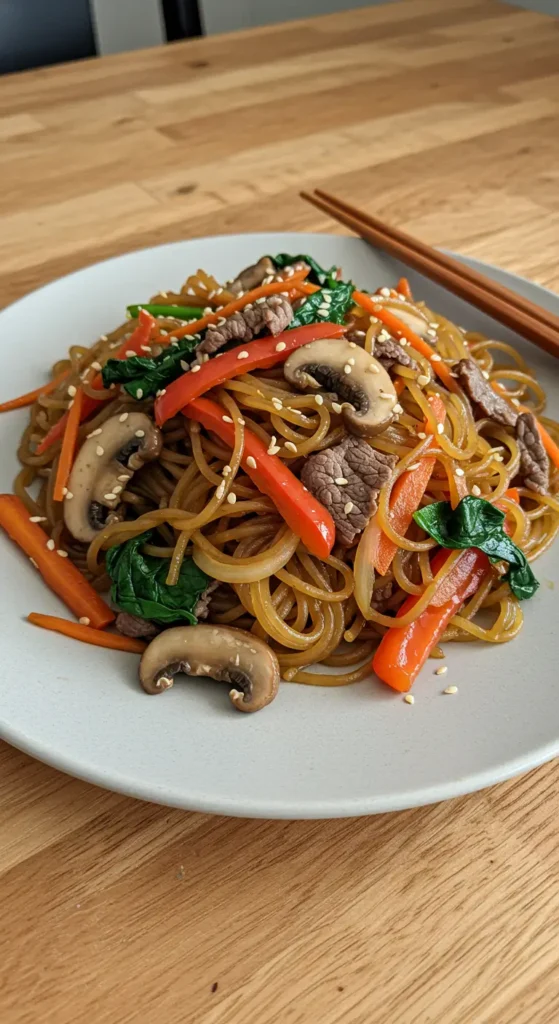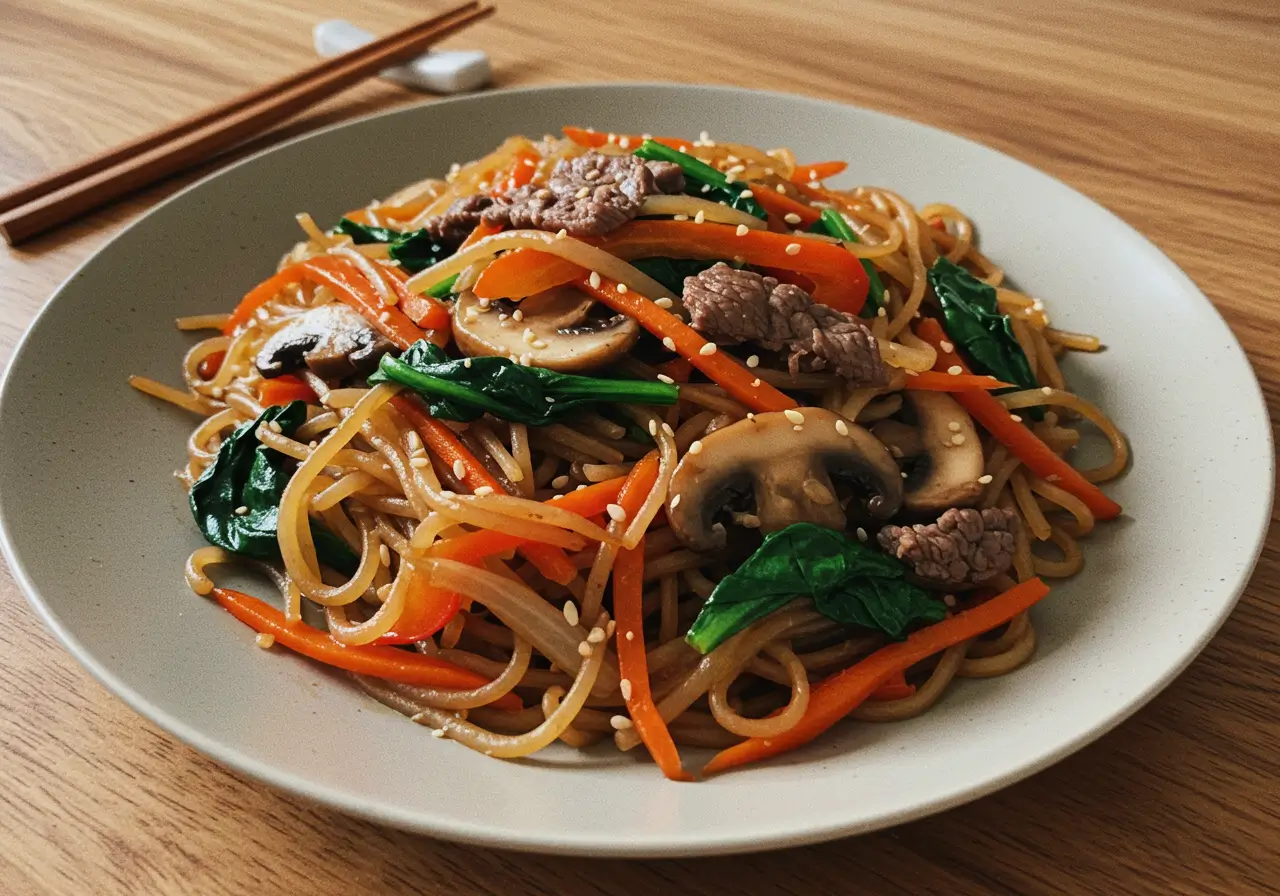Japchae Noodles Recipe
Table of Contents
Before we dive into the chewy, slippery magic of sweet potato noodles, let’s get cozy with what this article’s all about. Here, we’re taking a fun, deep-dish look at the beloved Japchae noodles recipe — from its colorful history to foolproof cooking steps, and even some tasty twists along the way. Whether you’re a Japchae rookie or you’ve slurped your fair share, you’ll find tips, tricks, and all the juicy secrets to make your next batch truly unforgettable. Stick around — it’s gonna be a delicious ride!
Essential Ingredients for Japchae Noodles Recipe

Main Ingredients Overview
When it comes to whipping up an unforgettable japchae noodles recipe, starting with the right ingredients is half the battle. First and foremost, you’ll need sweet potato noodles — also known as dangmyeon. These beauties turn clear and chewy after cooking, giving Japchae its signature texture.
Alongside the noodles, fresh vegetables like carrots, spinach, shiitake mushrooms, and bell peppers bring a rainbow of color and crunch. Plus, a protein like beef, chicken, or even tofu kicks things up a notch. And don’t forget the essential flavor boosters: soy sauce, sesame oil, garlic, and a sprinkle of sesame seeds.
Truth be told, it’s this colorful combo that makes the japchae noodles recipe not just delicious but also downright pretty!
Choosing the Right Noodles for Japchae
Now, let’s talk noodles. Not all noodles are created equal, right? For an authentic japchae noodles recipe, you’ll want to grab Korean sweet potato noodles. They’re slightly thicker than regular glass noodles and get that perfect bouncy, slippery bite.
However, if you’re in a pinch, glass noodles (like bean thread noodles) can step in. Just keep an eye out — some substitutions may cook faster and can turn mushy if you’re not careful.
Pro tip: Always rinse your noodles under cold water after boiling. This little trick stops the cooking process and keeps them from sticking together later!
Best Vegetables and Meat for Japchae
Honestly, Japchae is super flexible when it comes to veggies. Classic picks include carrots, spinach, shiitake mushrooms, and onions. Red bell peppers add a pop of sweetness, too.
As for the meat, thinly sliced beef is the gold standard. Short rib or ribeye works like a charm because it stays juicy even with quick stir-frying. But hey, if you’re feeling adventurous (or just keeping it vegetarian), tofu or mushrooms make fantastic substitutes!
When you mix it all together? You’re in for a colorful, healthy feast that’ll wow any crowd!
How to Make Japchae Noodles Step-by-Step

Preparing the Ingredients Properly
Alright, ready to roll up your sleeves? First things first: prep is everything when making a killer japchae noodles recipe. Start by slicing your vegetables thinly — aim for even, matchstick-like pieces. This way, they’ll cook quickly and evenly.
Then, marinate your beef (or tofu) with a simple blend of soy sauce, garlic, and a touch of sugar. While the protein soaks up the flavor, you can boil your noodles according to the package directions.
Oh, and don’t forget! Give those cooked noodles a quick rinse under cold water. Trust me, this small step makes a big difference in keeping them chewy instead of clumpy.
Cooking the Japchae Noodles Perfectly
Here’s where the magic happens. Instead of throwing everything into the pan at once (chaos, anyone?), Japchae comes together with care.
First, sauté the mushrooms, onions, and white parts of the green onions. Once softened, set them aside. Then stir-fry the carrots and peppers separately. This method keeps each veggie’s flavor bright and fresh.
Cook your marinated beef next — just a quick flash in a hot pan until barely browned. No overcooking allowed!
Lastly, toss the noodles in the flavorful sauce, followed by the veggies and beef. Be gentle, but make sure every strand gets a shiny, savory coat.
Assembling and Mixing Everything Together
Finally, it’s time to bring it all together. In a massive bowl (yes, the bigger the better), layer the sauced noodles, veggies, and beef. Toss everything like you mean it — but carefully enough so nothing turns to mush.
Sprinkle with toasted sesame seeds for that final nutty punch. And voilà! Your homemade japchae noodles recipe is ready to steal the show.
Tips for the Best Japchae Noodles Recipe
Secrets to Perfectly Textured Japchae
Getting that dreamy chew and glossy shine in your japchae noodles recipe doesn’t just happen by accident — oh no! It’s all about the little tricks. First, don’t overcook the noodles. Even a minute too long can turn them from bouncy to blah. Always boil until just tender, then rinse them under cold water to stop the cooking right in its tracks.
Another golden tip? Stir-fry the vegetables separately! Sure, it’s a bit more work, but doing this locks in their bright colors and keeps each bite full of unique flavors. Plus, it avoids that dreaded mushy veggie mix-up.
Lastly, when tossing everything together, do it gently but thoroughly. You want every slippery noodle to soak up that delicious sauce without getting squished.
Common Mistakes to Avoid
Even seasoned cooks can trip up! One common mistake when tackling a japchae noodles recipe is overloading the pan. Crowding your ingredients makes them steam rather than stir-fry, stealing that irresistible crispness.
Also, skipping the noodle rinse is a no-no. Without it, your noodles might clump into a sticky ball — yikes! And hey, while soy sauce is a hero ingredient, pouring it straight onto the noodles without mixing a dressing first can lead to uneven flavors.
Avoid these pitfalls, and your homemade Japchae will taste just like it came from a bustling Korean kitchen!
For more delicious recipes, be sure to check out other dishes on Smaczne Gotowanie!
Variations of Japchae Noodles
Vegetarian and Vegan Japchae Options
Good news — Japchae noodles recipes are incredibly easy to make vegetarian or even vegan. Simply ditch the meat and load up on extra veggies like broccoli, zucchini, or even baby corn. Swap the beef marinade with a little extra soy sauce, sesame oil, and a sprinkle of sugar for depth.
To boost the protein factor without meat, toss in cubes of pan-fried tofu or tempeh. Oh, and mushrooms — especially shiitake or oyster — bring an unbeatable meaty texture. Trust me, you won’t miss the beef one bit!
With the same slippery noodles and rich sauce, a vegan japchae noodles recipe can be just as mouthwatering.
Gluten-Free and Low-Carb Japchae Variations
If you’re steering clear of gluten, you’re in luck! Traditional dangmyeon noodles are already gluten-free since they’re made from sweet potato starch. However, double-check the soy sauce — regular ones can sneak in wheat. Grab a certified gluten-free version, like tamari, to stay safe.
Now, if you’re aiming for low-carb, the swap is a bit trickier. While sweet potato noodles aren’t low-carb, you could experiment with shirataki noodles or spiralized veggie “noodles” like zucchini. Sure, it’s not exactly traditional, but it still captures the spirit of Japchae: colorful, light, and packed with flavor.
At the end of the day, whatever version you whip up, the japchae noodles recipe can flex to match your lifestyle — and still taste absolutely amazing.
How to Serve and Store Japchae Noodles
Best Ways to Serve Japchae for Meals or Parties
Let’s be real — a japchae noodles recipe is a total showstopper at any gathering! Traditionally, Japchae is served barely warm or at room temperature, which makes it crazy convenient for parties, potlucks, or even fancy lunches.
Want to impress guests? Plate it up on a big, colorful platter and sprinkle toasted sesame seeds all over. You can even top it with thin egg strips or extra sautéed veggies for a wow-worthy finish.
Plus, Japchae pairs beautifully with grilled meats, Korean BBQ spreads, or even a simple soup. No matter how you serve it, it’ll disappear fast — guaranteed!
How to Store and Reheat Japchae Noodles Properly
Here’s the good news: your homemade japchae noodles recipe keeps like a champ! Store leftovers in an airtight container in the fridge for up to three days. Because the noodles can stiffen a little, splash a spoonful of water or sesame oil over them before reheating.
To warm them up, either use a skillet over medium heat or zap them in the microwave for about 30–60 seconds. Stir gently to keep everything tender and delicious.
Pro tip: Japchae actually tastes amazing cold too! So, don’t stress if you’re grabbing it straight from the fridge for a quick bite.
Health Benefits of Japchae Noodles
Nutritional Profile of Japchae
You might think a japchae noodles recipe is just indulgent comfort food — but surprise, it’s packed with goodness too! Thanks to the variety of colorful vegetables, Japchae is rich in vitamins like A, C, and K. Plus, you get a decent hit of fiber, potassium, and iron.
Sweet potato noodles themselves are naturally gluten-free and lower in calories than wheat-based options. So even though it tastes rich, Japchae can fit easily into a balanced diet.
Why Japchae is a Balanced Meal Option
Here’s the kicker — Japchae isn’t just tasty, it’s pretty well-rounded! Between the chewy noodles for energy, the vibrant veggies for fiber and nutrients, and the protein from beef or tofu, it’s a full meal in one gorgeous bowl.
Because it’s stir-fried lightly and not drowned in heavy sauces, a japchae noodles recipe delivers loads of flavor without feeling greasy or heavy. Honestly, it’s one of those rare dishes that tastes indulgent but treats your body right too!
Print
Authentic Japchae Noodles Recipe – A Complete Guide
- Total Time: PT35M
- Yield: Serves 5
- Diet: Gluten Free
Description
Learn how to make an authentic Japchae noodles recipe with chewy sweet potato noodles, vibrant vegetables, and savory-sweet sesame soy sauce. Perfect for parties, meal prep, or a colorful family Lunch, this traditional Korean dish is naturally gluten-free and bursting with flavor.
Ingredients
- 250g sweet potato noodles (dangmyeon)
- 300g beef short ribs or boneless ribeye, thinly sliced
- 1 onion, sliced into wedges
- 3 green onion stems, cut into 2-inch pieces
- 2 carrots, cut into thin batons
- 1 red bell pepper, thinly sliced
- 200g fresh shiitake mushrooms, sliced
- 4 ½ cups baby spinach
- 4 tbsp vegetable oil (divided)
- 2 tbsp white sesame seeds
- 2 tsp soy sauce (for beef marinade)
- 2 tsp white sugar (for beef marinade)
- 2 tsp minced garlic (for beef marinade)
- 1/2 tsp black pepper (for beef marinade)
- 1/4 cup soy sauce (for noodle dressing)
- 1 1/2 tbsp sesame oil (for noodle dressing)
- 1/2 tsp salt (divided)
Instructions
- Cook sweet potato noodles according to package instructions (around 8 minutes). Rinse with cold water and drain well.
- Mix the noodle dressing ingredients in a large bowl and add the noodles without tossing.
- Marinate beef slices with soy sauce, sugar, garlic, and black pepper for 20 minutes.
- Heat 2 tbsp oil in a pan and sauté onions, mushrooms, and the white parts of green onions with 1/2 tsp salt until softened. Transfer to the noodle bowl.
- Add 1 tbsp oil to the pan. Stir-fry carrots and bell peppers for about 1½ minutes. Toss in spinach and green onion greens and cook until wilted. Transfer to the bowl.
- Add final tbsp of oil to the pan. Quickly stir-fry marinated beef until cooked through, about 90 seconds. Transfer to the bowl.
- Sprinkle sesame seeds and toss everything gently but thoroughly until well mixed and glossy.
- Serve warm or at room temperature, topped with extra sesame seeds if desired.
Notes
- Rinse noodles after boiling to keep them chewy and prevent clumping.
- Vegetarian version: replace beef with tofu or more mushrooms.
- Use gluten-free soy sauce like tamari if needed.
- Japchae tastes great even when served cold or at room temperature.
- Prep Time: PT20M
- Cook Time: PT15M
- Category: Lunch, Dinner
- Method: Stir-Fry
- Cuisine: Korean
Nutrition
- Serving Size: 1 serving
- Calories: 504 kcal
- Sugar: 9g
- Sodium: 1590mg
- Fat: 24g
- Saturated Fat: 4g
- Unsaturated Fat: 18g
- Trans Fat: 0.04g
- Carbohydrates: 58g
- Fiber: 6g
- Protein: 18g
- Cholesterol: 35mg
Keywords: Japchae noodles recipe, Korean glass noodles, sweet potato noodles recipe, homemade japchae, stir-fried glass noodles, japchae with beef, traditional japchae
FAQs About Japchae Noodles Recipe
Can I make japchae ahead of time?
Yes, you sure can! One awesome thing about a japchae noodles recipe is how well it holds up. In fact, making it a few hours ahead gives the flavors extra time to blend beautifully. Just keep it in an airtight container and leave it at room temperature if you’re serving it within a few hours.
If you need it for the next day, pop it into the fridge and gently reheat before serving. Easy peasy!
Do japchae noodles need to be rinsed after boiling?
Absolutely! After boiling, give those noodles a cold water rinse. This little move stops them from cooking further and getting mushy. Plus, it helps keep them beautifully chewy, which is the real heart of a great japchae noodles recipe.
Can I freeze leftover japchae?
Technically, you can freeze it, but here’s the deal — it’s not the best idea. Freezing changes the texture of the noodles and veggies, making them a bit soggy. If you must freeze it, wrap tightly and eat within a month. Still, fresh is always best for that authentic chew!
What’s a good substitute for sweet potato noodles?
If you can’t find dangmyeon, go for glass noodles (bean thread noodles) instead. While they aren’t quite the same, they still deliver that slippery, satisfying bite.
How long does japchae last in the fridge?
Stored properly, a japchae noodles recipe can stay fresh in the fridge for up to three days. Just reheat gently and enjoy a quick, tasty meal anytime!

